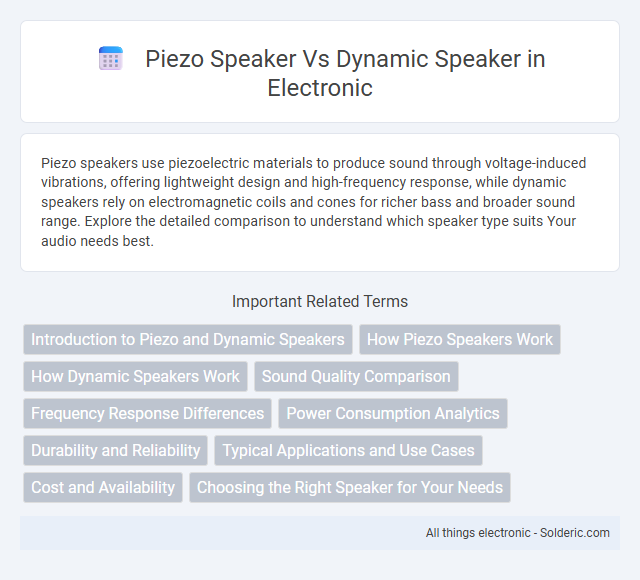Piezo speakers use piezoelectric materials to produce sound through voltage-induced vibrations, offering lightweight design and high-frequency response, while dynamic speakers rely on electromagnetic coils and cones for richer bass and broader sound range. Explore the detailed comparison to understand which speaker type suits Your audio needs best.
Comparison Table
| Feature | Piezo Speaker | Dynamic Speaker |
|---|---|---|
| Operating Principle | Piezoelectric effect - converts electrical signals to mechanical vibrations | Electromagnetic induction - uses a voice coil and magnet |
| Frequency Response | Typically 1 kHz to 30 kHz (high frequencies) | Wide range, typically 20 Hz to 20 kHz (full audible spectrum) |
| Sound Quality | Sharp, high-pitched tones; limited bass | Rich, full sound with bass and midrange |
| Impedance | High impedance, often >1 kO | Low impedance, typically 4-16 O |
| Power Consumption | Low power consumption | Higher power consumption |
| Durability | Resistant to environmental conditions, rugged | More sensitive to physical damage and moisture |
| Cost | Generally low cost | Generally higher cost |
| Applications | Alarms, buzzers, timers, lightweight beepers | Music playback, headphones, speakers, audio devices |
Introduction to Piezo and Dynamic Speakers
Piezo speakers utilize piezoelectric materials to convert electrical signals directly into sound through mechanical vibrations, offering high-frequency response and efficiency in compact designs. Dynamic speakers rely on electromagnetic principles, using a voice coil attached to a diaphragm that moves within a magnetic field to produce a wide range of audio frequencies with robust sound quality. While piezo speakers excel in applications requiring lightweight and durable sound solutions, dynamic speakers dominate in delivering richer, full-spectrum audio performance.
How Piezo Speakers Work
Piezo speakers operate by converting electrical signals into mechanical vibrations using the piezoelectric effect, where an applied voltage causes a piezoelectric material to change shape rapidly, producing sound waves. Unlike dynamic speakers that rely on electromagnetic coils and cones, piezo speakers are lightweight, have no magnetic components, and excel in high-frequency sound reproduction. Understanding how piezo speakers work can help you choose the right audio device for applications requiring efficient and durable high-frequency sound output.
How Dynamic Speakers Work
Dynamic speakers operate through electromagnetic induction, where an alternating current passes through a coil attached to a diaphragm within a magnetic field, causing the coil and diaphragm to move and produce sound waves. The diaphragm's movement pushes and pulls air, generating audible sound that accurately reproduces a wide range of frequencies. This mechanism allows dynamic speakers to deliver rich, natural sound with strong bass response and high power handling capabilities.
Sound Quality Comparison
Piezo speakers deliver crisp, high-frequency sounds with low distortion but lack deep bass and overall richness found in dynamic speakers. Dynamic speakers offer a broader frequency response and superior sound quality, producing clear mids and robust bass, making them ideal for immersive audio experiences. While piezo speakers excel in compact, energy-efficient designs, dynamic speakers provide a fuller, more natural sound suitable for music and multimedia applications.
Frequency Response Differences
Piezo speakers typically exhibit a narrower frequency response, often ranging from 1 kHz to 20 kHz, making them ideal for high-frequency signals and alert tones. Dynamic speakers provide a broader frequency response, usually spanning from 20 Hz to 20 kHz, allowing for richer bass and overall sound quality suitable for music playback. The inherent materials and design differences cause piezo speakers to excel in durability and efficiency at higher frequencies, while dynamic speakers deliver more balanced audio performance across the full audible spectrum.
Power Consumption Analytics
Piezo speakers consume significantly less power due to their capacitive nature, making them ideal for energy-efficient applications. Dynamic speakers require higher power to drive their voice coils and magnets, resulting in increased energy usage. Your choice between the two should consider power consumption analytics to optimize battery life in portable devices.
Durability and Reliability
Piezo speakers are known for their exceptional durability and reliability due to their solid-state construction, which makes them resistant to environmental factors such as moisture, dust, and temperature extremes. Dynamic speakers, with their moving coil and cone components, can be more susceptible to wear and mechanical failure over time, especially under high-stress conditions. Piezo speakers typically offer longer service life in harsh environments, making them ideal for industrial and outdoor applications where consistent performance is critical.
Typical Applications and Use Cases
Piezo speakers excel in applications requiring high-frequency sound and compact size, such as electronic alarms, medical devices, and small-scale signal notifications. Dynamic speakers are preferred in audio systems demanding rich sound quality and broad frequency range, including home audio systems, headphones, and musical instruments. Both speaker types serve distinct purposes, with piezo speakers favored for efficiency in niche uses and dynamic speakers dominating in immersive audio experiences.
Cost and Availability
Piezo speakers are generally more affordable and widely available in electronic components markets due to their simple construction and low material costs. Dynamic speakers tend to be pricier because of their complex design involving magnetic coils and cones, but they offer higher sound quality for audio applications. Your choice between the two depends on balancing budget constraints with desired audio performance and availability.
Choosing the Right Speaker for Your Needs
Piezo speakers excel in applications requiring high-frequency sound with low power consumption and durability, making them ideal for alarms and lightweight devices. Dynamic speakers offer richer audio quality with better bass response, suited for music playback and multimedia experiences. Selecting the right speaker depends on prioritizing sound quality versus efficiency and durability based on the specific use case.
Piezo speaker vs dynamic speaker Infographic

 solderic.com
solderic.com